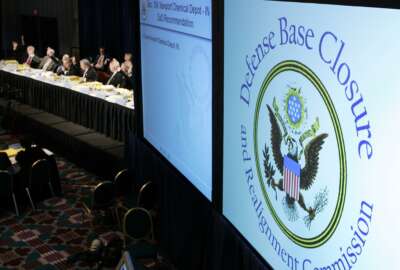
Democratic VP candidate has a BRAC plan
Sen. Tim Kaine (D-Va.) wants DoD to recommend to Congress what bases need to be closed and let lawmakers vote on the closures individually.
Hilary Clinton’s pick for vice president is advocating for the Defense Department to take a bolder approach to base realignment and closure.
Sen. Tim Kaine (D-Va.) wants DoD to make recommendations directly to Congress on what bases should be closed, instead of relying on commission to weed out what bases need to be axed.
“The Pentagon makes recommendations to Congress every year. Buy this weapons system, don’t buy that one. Change military benefits this way, not that way. They make recommendations to us on really controversial things and you know what we do in Congress? We accept about 65 percent of them, we change about 20 percent of them and we say ‘Hell no’ to about 15 percent of them,” Kaine said July 20 at a Northern Virginia Chamber event in Fairfax, Virginia. “We are perfectly capable of taking professional recommendations and then out of our own perspective accepting some and not all.”
Kaine is a member of the Senate Armed Services Committee. He added that he understands the politics of shrinking or closing a base are hard, but he thinks DoD should treat infrastructure like it treats everything else that is controversial and just make a recommendation.
The process for closing excess bases now works through a commission established by Congress. DoD gives the commission a list of bases it wants to close and then the commission assesses those bases on certain criteria. After the commission releases the list, Congress votes on closing all the bases on the list or not.
Kaine said that process is a money drain in towns and states.
“When a BRAC round gets announced every community has to hire lobbyist and lawyers to make their case. Even a community whose military installations are in no danger of shutting down, but imagine being the mayor that didn’t put the committee together and the risk that it is shut down and you’re voted out. So everybody hires lobbyist and lawyers and it just wastes tons of money. … I just don’t think it’s a great process because it makes everybody frightened and everybody spends a lot of money,” Kaine said.
Congress hasn’t approved a round of BRAC since 2005. The Senate version of the 2017 defense authorization bill explicitly prohibits another round of BRAC for 2017.
DoD has been pleading with Congress to do another round, however.
The Pentagon has asked unsuccessfully for another BRAC round in its last five consecutive budgets. An April report by DoD pegs a “conservative” estimate of excess infrastructure at 22 percent.
That means DoD is paying to maintain 22 percent more military base infrastructure than it can put to practical use.
The Army has 33 percent more stateside infrastructure than it needs, according to the report. Similarly, the Air Force has an excess of 32 percent. But the Navy and Marine Corps have just 7 percent extra, and facilities managed by the Defense Logistics Agency have 12 percent.
DoD has also been trying to make up for some of the faults from the first BRAC round.
“The department is not happy with what happened in the 2005 BRAC round in terms of cost take-out. We rebalanced the force in some useful ways, but we think a future BRAC round would have much different financial ramifications,” Jamie Morin, director of Cost Assessment and Program Evaluation said in March. “We just need to move forward on this to enable a whole bunch of cost takeout to drive more combat capability out of each taxpayer dollar.”
Morin said it’s not the physical maintenance of the bases that is so detrimental to the budget, but rather the extra personnel on a base that does the maintenance.
An average base needs 800 to 900 people in it before you get to operational employees, Morin said.
“As you shrink down the operational forces, as we get higher and higher technology and the capital gets more expensive because it’s more and more advanced, we are operating with a constant physical infrastructure with a lot of overhead to maintain it,” Morin said.
Copyright © 2025 Federal News Network. All rights reserved. This website is not intended for users located within the European Economic Area.
Scott Maucione is a defense reporter for Federal News Network and reports on human capital, workforce and the Defense Department at-large.
Follow @smaucioneWFED




